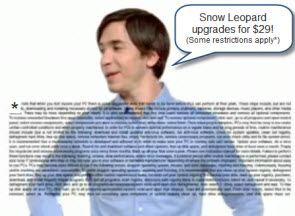Windows 7 versus Snow Leopard: How much do upgrades really cost?

In one of its brilliant “I’m a Mac” ads recently, Apple lampooned the complexity of Microsoft Windows with a dizzying display of fine print that eventually filled up the screen and covered up both characters.
I thought of that ad when I saw Apple’s recent announcement that it was going to make its next Mac OS X upgrade, Snow Leopard, available as a $29 upgrade. That sounds so much better than the broad range of prices that Microsoft is going to charge its customers for Windows 7 upgrades. Too bad the $29 upgrade is not that simple. In fact, according to my analysis of Apple’s own sales figures, 57% of Apple's customers who bought and paid for new Macs in the past five years are ineligible for those cheap upgrades.

That hasn’t stopped casual observers and even some seasoned analysts from falling for Apple’s ruse. Michael Gartenberg, for example, issued this critique in response to Microsoft’s announcement of Windows 7 pricing:
Apple showed the way. Snow Leopard is also not [a] major update but rather an enhanced version of Leopard. With an upgrade price of $29, that’s about where MSFT should be for the Home Premium version of 7…
Yes, $29 for an OS upgrade sounds like a great deal, if you qualify. But do you? I looked at the fine print for this offer, and was shocked—shocked, I tell you—to discover that the majority of Mac owners don’t qualify for that pricing. In fact, a significant number of Mac owners won’t be able to upgrade to Snow Leopard at any price.
Details after the jump.
According to Microsoft, roughly 90% of Windows users purchase the operating system preinstalled with a new PC. And if you ignore the Hackintosh crowd, 100% of Mac owners purchase OS X with a new Mac. Any PC purchased with Windows XP or Windows Vista since October 2001 qualifies for a discounted upgrade to Windows 7, for a price as low as $50. But only a select group of Mac owners qualify for those $29 upgrades. A large number will have to pay $169 for the privilege of installing Snow Leopard, and another large group of Apple customers won’t be able to install Snow Leopard at all.
So where do you stand? Find the date when you bought a new PC or Mac and look in the table below. The Windows 7 numbers represent the cost of a Home Premium upgrade, which will be available for the next two weeks for $50 and then will be set at an estimated retail price of $120 after the OS ships on October 22. The upgrade cost is $0 from June 26, 2009 to January 31, 2010, thanks to Microsoft's Windows 7 Upgrade Option program.
PC/Mac purchase date | Windows 7 upgrade cost | Snow Leopard upgrade cost |
| October 2001 - Jan 2006 | $50 - $120 | Not supported |
| Jan 2006 - Sep 2007 | $50 - $120 | $158-169 (Intel only) |
| Oct 2007 – Jun 2009 | $50 - $120 | $29 |
| Jun 2009 or later | $0 | $0 |
Apple’s core market for the $29 upgrade is its most loyal group of hardware buyers, who’ve already paid their “Apple tax” at the highest marginal rate. You qualify for that $29 upgrade price if you are one of the 15 million or so people who spent $1000 or more for a new Mac in the past 21 months. (Yes, I’m leaving out the Mac Mini, which sells for under a grand but represents a minuscule fraction of Apple’s sales—less than 7% according to one analyst’s rough estimate.) Any Mac purchased after October 1, 2007 satisfies the upgrade criteria: an Intel-based system running Mac OS X version 10.5 (Leopard).
That leaves out a huge number of Apple's customers.
From January 2006 through September 2007, according to Apple’s financial reports, 11.1 million people purchased new Macs. All of them came with OS X Tiger installed. If you paid Apple $129 for a copy of Leopard at some point along the way and your system has an Intel processor, you qualify for the right to pay Apple an extra $29, making your total upgrade cost $168 $158 [math error corrected]. If you own one of those 2006-2007 PCs and are still running Tiger, the upgrade to Snow Leopard will cost you $169, which is the price of the Mac Box Set.
If you purchased a new Mac before January 9, 2006, you can’t upgrade to Snow Leopard at any price. That’s because systems built before that date were based on the PowerPC processor, which is not supported by Snow Leopard. According to Apple’s own numbers, more than 8.2 million customers bought Macs in 2004 and 2005. All are now officially orphaned by Apple. And that number understates the true count. Apple didn’t complete its transition to the Intel platform until August 2006, and its likely that some older PowerPC-based machines were still in the sales channel in early 2007.
Apple has been selling its OS upgrades for $129 since the introduction of OS X in 2001. Microsoft has been similarly consistent with its pricing throughout Windows’ lifespan. If Windows 7 didn’t exist, how much would Apple be selling Snow Leopard for? (Hint: The correct answer has three digits.)
Apple’s $29 pricing decision is a clever one. They’re counting on gullible reporters and analysts to make oversimplified comparisons with Windows 7, and they're hoping to goad Ballmer and Company into reacting with a slashed price of their own. If Microsoft is smart, they won't take the bait.